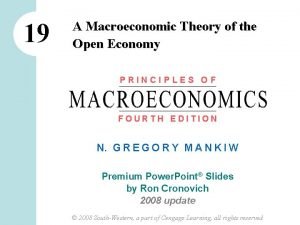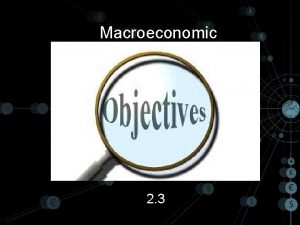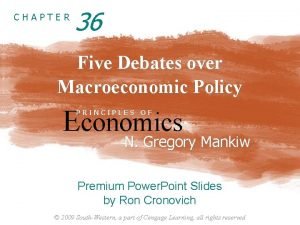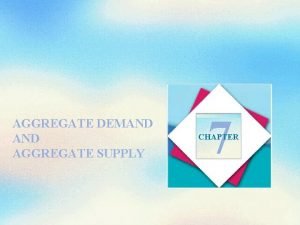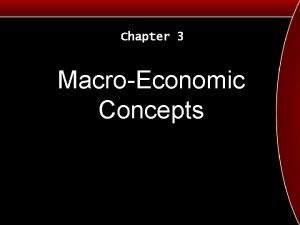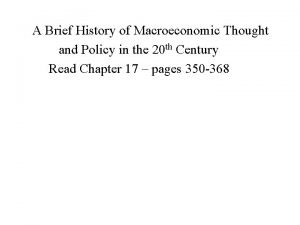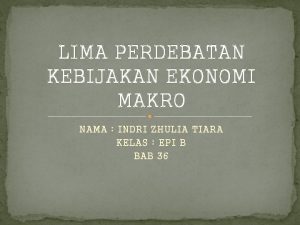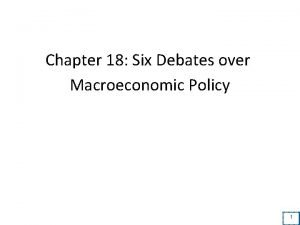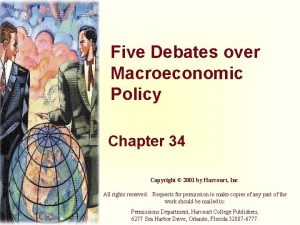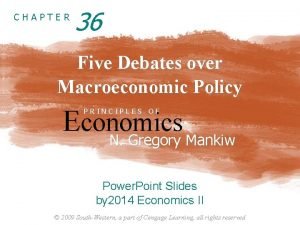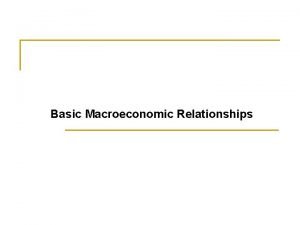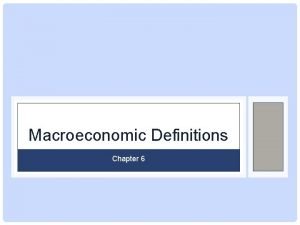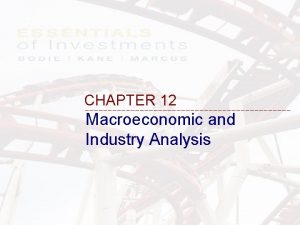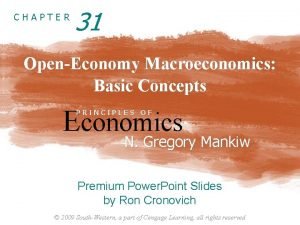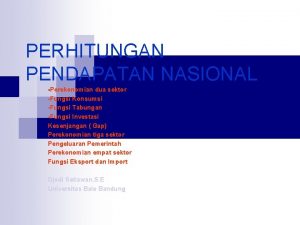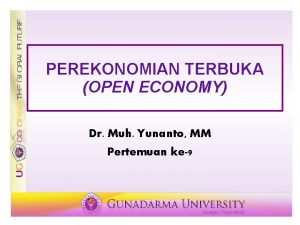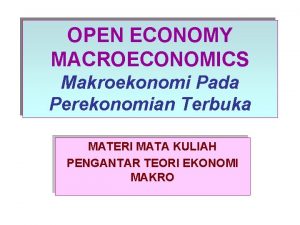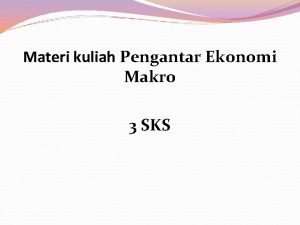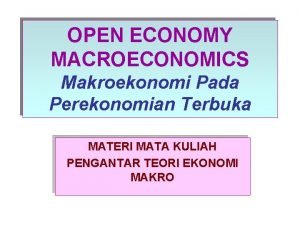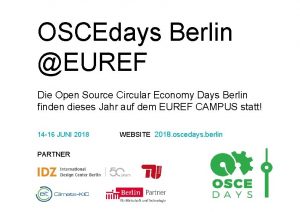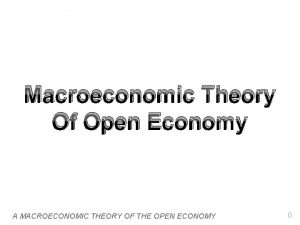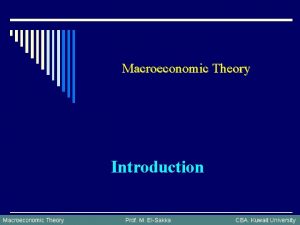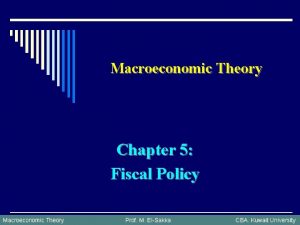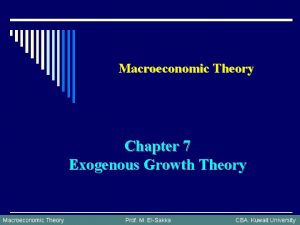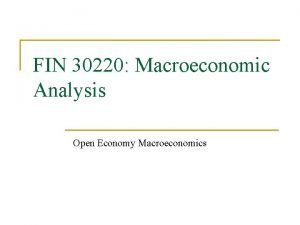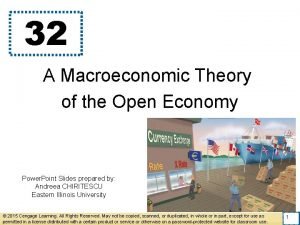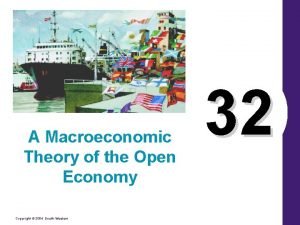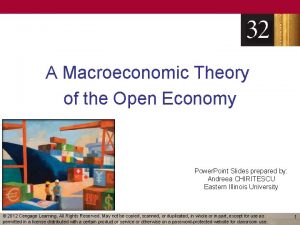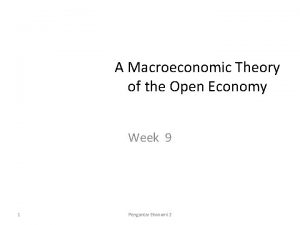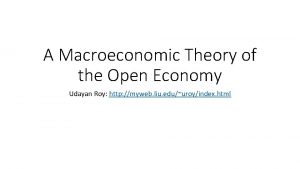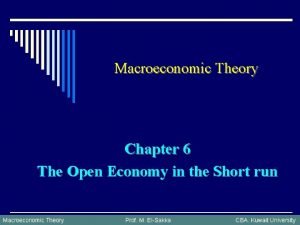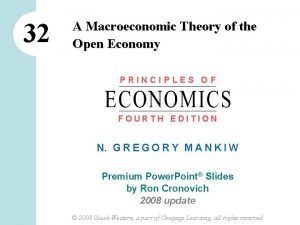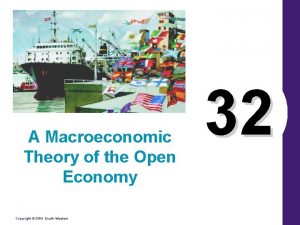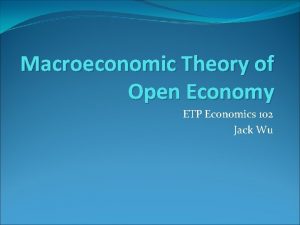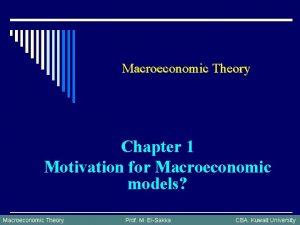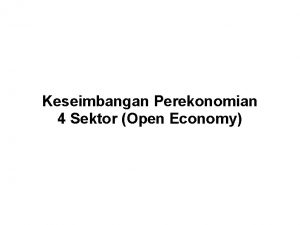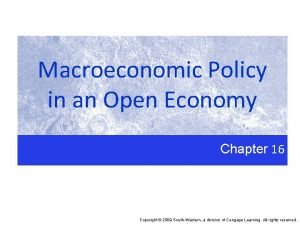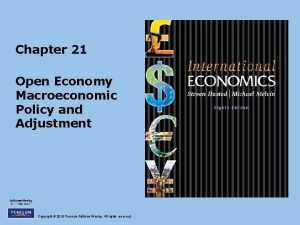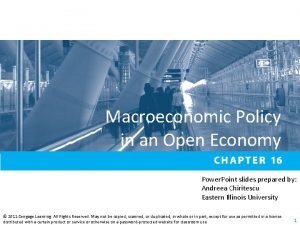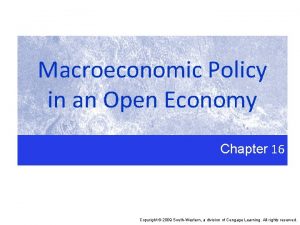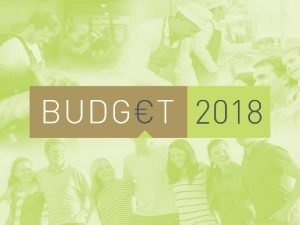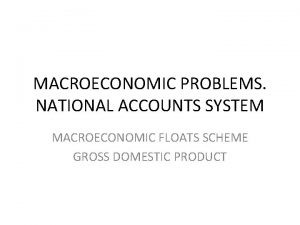32 A Macroeconomic Theory of the Open Economy





































- Slides: 37

32 A Macroeconomic Theory of the Open Economy PRINCIPLES OF FOURTH EDITION N. G R E G O R Y M A N K I W Power. Point® Slides by Ron Cronovich © 2007 Thomson South-Western, all rights reserved

In this chapter, look for the answers to these questions: § In an open economy, what determines the real interest rate? The real exchange rate? § How are the markets for loanable funds and foreign-currency exchange connected? § How do government budget deficits affect the exchange rate and trade balance? § How do other policies or events affect the interest rate, exchange rate, and trade balance? CHAPTER 32 A MACROECONOMIC THEORY OF THE OPEN ECONOMY 1

Introduction § The previous chapter explained the basic concepts and vocabulary of the open economy: net exports (NX), net capital outflow (NCO), and exchange rates. § This chapter ties these concepts together into a theory of the open economy. § We will use this theory to see how govt policies and various events affect the trade balance, exchange rate, and capital flows. § We start with the loanable funds market… CHAPTER 32 A MACROECONOMIC THEORY OF THE OPEN ECONOMY 2

The Market for Loanable Funds § An identity from the preceding chapter: S = I + NCO Saving Domestic investment Net capital outflow § Supply of loanable funds = saving. § A dollar of saving can be used to finance • • the purchase of domestic capital the purchase of a foreign asset § So, demand for loanable funds = I + NCO CHAPTER 32 A MACROECONOMIC THEORY OF THE OPEN ECONOMY 3

The Market for Loanable Funds § Recall: • S depends positively on the real interest rate, r. • I depends negatively on r. § What about NCO? CHAPTER 32 A MACROECONOMIC THEORY OF THE OPEN ECONOMY 4

How NCO Depends on the Real Interest Rate The real interest rate, r, is the real return on domestic assets. A fall in r makes domestic assets less attractive relative to foreign assets. • • • r r 1 r 2 People in the U. S. purchase more foreign assets. People abroad purchase fewer U. S. assets. NCO rises. CHAPTER 32 Net capital outflow NCO NCO 1 NCO 2 A MACROECONOMIC THEORY OF THE OPEN ECONOMY 5

The Loanable Funds Market Diagram r adjusts to balance supply and demand in the LF market. r Loanable funds S = saving r 1 Both I and NCO depend negatively on r, so the D curve is downward-sloping. D = I + NCO LF CHAPTER 32 A MACROECONOMIC THEORY OF THE OPEN ECONOMY 6

1: Budget deficits and capital flows ACTIVE LEARNING § Suppose the government runs a budget deficit (previously, the budget was balanced). § Use the appropriate diagrams to determine the effects on the real interest rate and net capital outflow. CHAPTER 32 A MACROECONOMIC THEORY OF THE OPEN ECONOMY 7

ACTIVE LEARNING Answers 1: When working with this model, keep in mind: The higherdeficit r makes U. S. saving bonds more attractive relative A budget reduces and the supply of LF, the LF market determines r (in left graph), to foreignr to bonds, causing rise. reduces NCO. then this value of r determines NCO (in right graph). Loanable funds Net capital outflow r r S 2 S 1 r 2 r 1 D 1 NCO 1 LF CHAPTER 32 A MACROECONOMIC THEORY OF THE OPEN ECONOMY NCO 8

The Market for Foreign-Currency Exchange § Another identity from the preceding chapter: NCO = NX Net capital outflow Net exports § In the market foreign-currency exchange, • NX is the demand for dollars, because foreigners need dollars to buy U. S. net exports. • NCO is the supply of dollars, because U. S. residents sell dollars to obtain the foreign currency they need to buy foreign assets. CHAPTER 32 A MACROECONOMIC THEORY OF THE OPEN ECONOMY 9

The Market for Foreign-Currency Exchange § Recall: The U. S. real exchange rate (E) measures the quantity of foreign goods & services that trade for one unit of U. S. goods & services. • E is the real value of a dollar in the market foreign-currency exchange. CHAPTER 32 A MACROECONOMIC THEORY OF THE OPEN ECONOMY 10

The Market for Foreign-Currency Exchange Anadjusts increase in E makes E to balance U. S. goods more supply and demand E expensive to the foreigners, for dollars in reducesfor foreign demand market foreignfor U. S. goods – and U. S. currency exchange. dollars. E 1 An increase in E has no effect on saving or investment, so it does not affect NCO or the supply of dollars. CHAPTER 32 S = NCO The Quantity of dollar supplied for the purpose of buying foreign assets. D = NX Dollars A MACROECONOMIC THEORY OF THE OPEN ECONOMY 11

2: The budget deficit, exchange rate, and NX ACTIVE LEARNING § Initially, the government budget is balanced and trade is balanced (NX = 0). § Suppose the government runs a budget deficit. As we saw earlier, r rises and NCO falls. § How does the budget deficit affect the U. S. real exchange rate? The balance of trade? CHAPTER 32 A MACROECONOMIC THEORY OF THE OPEN ECONOMY 12

ACTIVE LEARNING Answers The budget deficit reduces NCO and the supply of dollars. The real exchange rate appreciates, reducing net exports. Since NX = 0 initially, the budget deficit causes a trade deficit (NX < 0). CHAPTER 32 2: Market foreigncurrency exchange S 2 = NCO 2 E S 1 = NCO 1 E 2 E 1 D = NX Dollars A MACROECONOMIC THEORY OF THE OPEN ECONOMY 13

The “Twin Deficits” Net exports and the budget deficit often move in opposite directions. 5% Percent of GDP 4% 3% U. S. federal budget deficit 2% 1% 0% -1% -2% -3% U. S. net exports A MACROECONOMIC THEORY OF THE OPEN ECONOMY 2001 -05 1991 -95 1986 -90 1981 -85 1976 -80 1971 -75 1966 -70 CHAPTER 32 1961 -65 -5% 1995 -2000 -4%

The Effects of a Budget Deficit: Summary • • • national saving falls • • the real exchange rate appreciates the real interest rate rises domestic investment and net capital outflow both fall -> Any other implication than crowding out? net exports fall (or, the trade deficit increases) CHAPTER 32 A MACROECONOMIC THEORY OF THE OPEN ECONOMY 15

The Effects of a Budget Deficit: Summary § One other effect: As foreigners acquire more domestic assets, the country’s debt to the rest of the world increases. § Due to many years of budget and trade deficits, the U. S. is now the “world’s largest debtor nation. ” International investment position of the U. S. at end of 2004 Value of U. S. -owned foreign assets $10 trillion Value of foreign-owned U. S. assets $12. 5 trillion U. S. ’ net debt to the rest of the world $2. 5 trillion CHAPTER 32 A MACROECONOMIC THEORY OF THE OPEN ECONOMY 16

The Connection Between Interest Rates and Exchange Rates Anything that Keep in mind: increases r (not shown) The LF market determines will reduce NCO r. This value of of r and the supply then determines NCO dollars in the foreign (shown in market. upper graph). exchange This value of NCO then Result: determines supply of The real exchange dollars in foreign exchange rate appreciates. market (in lower graph). CHAPTER 32 r r 2 r 1 NCO NCO 2 E S 2 NCO 1 S 1 = NCO 1 E 2 E 1 D = NX dollars NCO 2 NCO 1 A MACROECONOMIC THEORY OF THE OPEN ECONOMY 17

3: Investment incentives ACTIVE LEARNING § Suppose the government provides new tax incentives to encourage investment. § Use the appropriate diagrams to determine how this policy would affect: • the real interest rate • net capital outflow • the real exchange rate • net exports CHAPTER 32 A MACROECONOMIC THEORY OF THE OPEN ECONOMY 18

ACTIVE LEARNING Answers 3: r. Investment rises, – and the demand for LF – increase at each causing to fall. value of NCO r. r Loanable funds r Net capital outflow S 1 r 2 r 1 D 1 D 2 NCO LF CHAPTER 32 NCO 1 NCO A MACROECONOMIC THEORY OF THE 2 OPEN ECONOMY NCO 19

ACTIVE LEARNING Answers The fall in NCO reduces the supply of dollars in the foreign exchange market. The real exchange rate appreciates, reducing net exports. 3: Market foreigncurrency exchange S 2 = NCO 2 E S 1 = NCO 1 E 2 E 1 D = NX Dollars CHAPTER 32 A MACROECONOMIC THEORY OF THE OPEN ECONOMY 20

Budget Deficit vs. Investment Incentives § A tax incentive for investment has similar effects as a budget deficit: • r rises, NCO falls • E rises, NX falls § But one important difference: • Investment tax incentive increases investment, • which increases productivity growth and living standards in the long run. Budget deficit reduces investment, which reduces productivity growth and living standards. CHAPTER 32 A MACROECONOMIC THEORY OF THE OPEN ECONOMY 21

Trade Policy § Trade policy: a govt policy that directly influences the quantity of g&s that a country imports or exports § Examples: • Tariff – a tax on imports • Import quota – a limit on the quantity of imports • “Voluntary export restrictions” – the govt pressures another country to restrict its exports; essentially the same as an import quota CHAPTER 32 A MACROECONOMIC THEORY OF THE OPEN ECONOMY 22

Trade Policy § Common reasons for policies to restrict imports: • to save jobs in a domestic industry that has difficulty competing with imports • to reduce the trade deficit § Do such trade policies accomplish these goals? § Let’s use our model to analyze the effects of an import quota on cars from Japan, designed to save jobs in the U. S. auto industry. CHAPTER 32 A MACROECONOMIC THEORY OF THE OPEN ECONOMY 23

Analysis of a Quota on Cars from Japan An import quota does not affect saving or investment, so it does not affect NCO. (Recall: NCO = S – I. ) r Loanable funds r Net capital outflow S r 1 D NCO LF CHAPTER 32 A MACROECONOMIC THEORY OF THE OPEN ECONOMY NCO 24

Analysis of a Quota on Cars from Japan Since NCO unchanged, S curve does not shift. The D curve shifts: At each E, imports of cars fall, so net exports rise, D shifts to the right. At E 1, there is excess demand in the foreign exchange market. E rises to restore eq’m. CHAPTER 32 Market foreigncurrency exchange E S = NCO E 2 E 1 D 2 D 1 Dollars A MACROECONOMIC THEORY OF THE OPEN ECONOMY 25

Analysis of a Quota on Cars from Japan, cont. What happens to NX? Nothing! § If E could remain at E 1, NX would rise, and the quantity of dollars demanded would rise. § But the import quota does not affect NCO, so the quantity of dollars supplied is fixed. § Since NX must equal NCO, E must rise enough to keep NX at its original level. § Hence, the policy of restricting auto imports from Japan does not reduce the trade deficit. CHAPTER 32 A MACROECONOMIC THEORY OF THE OPEN ECONOMY 26

Analysis of a Quota on Cars from Japan, cont. Does the policy save jobs? The quota reduces imports of Japanese autos. • U. S. consumers buy more U. S. autos. • U. S. automakers hire more workers to produce these extra cars. • So the policy saves jobs in the U. S. auto industry. But E rises, reducing foreign demand for U. S. exports. • Export industries contract, exporting firms lay off workers. The import quota saves jobs in the auto industry only by destroying jobs in U. S. export industries!! CHAPTER 32 A MACROECONOMIC THEORY OF THE OPEN ECONOMY 27

Political Instability and Capital Flight § 1994: Political instability in Mexico made world financial markets nervous. • People worried about the safety of Mexican assets they owned. • People sold many of these assets, pulled their capital out of Mexico. § Capital flight: a large and sudden reduction in the demand for assets located in a country § We analyze this using our model, but from the prospective of Mexico, not the U. S. CHAPTER 32 A MACROECONOMIC THEORY OF THE OPEN ECONOMY 28

Capital Flight from Mexico Demand The equilibrium forinvestors LF =values I + sell NCO. oftheir r and NCOand bothpull increase. As foreign assets out their The increase in NCO increases demand capital, NCO increases at each value of r. for LF. r Loanable funds r Net capital outflow S 1 r 2 r 1 D 1 D 2 NCO 1 LF CHAPTER 32 A MACROECONOMIC THEORY OF THE OPEN ECONOMY NCO 29

Capital Flight from Mexico The increase in NCO causes an increase in the supply of pesos in the foreign exchange market. The real exchange rate value of the peso falls. Market foreigncurrency exchange E S 1 = NCO 1 S 2 = NCO 2 E 1 E 2 D 1 Pesos CHAPTER 32 A MACROECONOMIC THEORY OF THE OPEN ECONOMY 30

Real-World Examples of Capital Flight § § Mexico, 1994 Southeast Asia, 1997 Russia, 1998 Argentina, 2002 In each of these cases, the country’s interest rates rose and its exchange rate depreciated, as our model predicts. CHAPTER 32 A MACROECONOMIC THEORY OF THE OPEN ECONOMY 31

CONCLUSION § The U. S. economy is becoming increasingly open: • Trade in g&s is rising relative to GDP. • Increasingly, people hold international assets in their portfolios and firms finance investment with foreign capital. CHAPTER 32 A MACROECONOMIC THEORY OF THE OPEN ECONOMY 32

CONCLUSION § Yet, we should be careful not to blame our problems on the international economy. • Our trade deficit is not caused by other countries’ “unfair” trade practices, but by our own low saving. • Stagnant living standards are not caused by imports, but by low productivity growth. § When politicians and commentators discuss international trade and finance, the lessons of this and the preceding chapter can help separate myth from reality. CHAPTER 32 A MACROECONOMIC THEORY OF THE OPEN ECONOMY 33

CHAPTER SUMMARY § In an open economy, the real interest rate adjusts to balance the supply of loanable funds (saving) with the demand for loanable funds (domestic investment and net capital outflow). § In the market foreign-currency exchange, the real exchange rate adjusts to balance the supply of dollars (net capital outflow) with the demand for dollars (net exports). § Net capital outflow is the variable that connects these markets. CHAPTER 32 A MACROECONOMIC THEORY OF THE OPEN ECONOMY 34

CHAPTER SUMMARY § A budget deficit reduces national saving, drives up interest rates, reduces net capital outflow, reduces the supply of dollars in the foreign exchange market, appreciates the exchange rate, and reduces net exports. § A policy that restricts imports does not affect net capital outflow, so it cannot affect net exports or improve a country’s trade deficit. Instead, it drives up the exchange rate and reduces exports as well as imports. CHAPTER 32 A MACROECONOMIC THEORY OF THE OPEN ECONOMY 35

CHAPTER SUMMARY § Political instability may cause capital flight, as nervous investors sell assets and pull their capital out of the country. As a result, interest rates rise and the country’s exchange rate falls. This occurred in Mexico in 1994 and in other countries more recently. CHAPTER 32 A MACROECONOMIC THEORY OF THE OPEN ECONOMY 36
 A macroeconomic theory of the open economy
A macroeconomic theory of the open economy Athenian economy vs sparta economy
Athenian economy vs sparta economy 영국 beis
영국 beis Macroeconomic objectives
Macroeconomic objectives Five debates over macroeconomic policy
Five debates over macroeconomic policy Macroeconomic equilibrium occurs:
Macroeconomic equilibrium occurs: Macroeconomics deals with
Macroeconomics deals with History of macroeconomic thought
History of macroeconomic thought Six debates over macroeconomic policy
Six debates over macroeconomic policy Six debates over macroeconomic policy
Six debates over macroeconomic policy Five debates over macroeconomic policy
Five debates over macroeconomic policy Five debates over macroeconomic policy
Five debates over macroeconomic policy Basic macroeconomic relationships
Basic macroeconomic relationships Macroeconomic definitions
Macroeconomic definitions Macroeconomic and industry analysis
Macroeconomic and industry analysis Chapter 31 open economy macroeconomics
Chapter 31 open economy macroeconomics Open economy
Open economy Open economy
Open economy Open economy
Open economy Open economy
Open economy Open economy adalah
Open economy adalah Open source circular economy
Open source circular economy Hát kết hợp bộ gõ cơ thể
Hát kết hợp bộ gõ cơ thể Frameset trong html5
Frameset trong html5 Bổ thể
Bổ thể Tỉ lệ cơ thể trẻ em
Tỉ lệ cơ thể trẻ em Voi kéo gỗ như thế nào
Voi kéo gỗ như thế nào Tư thế worm breton là gì
Tư thế worm breton là gì Bài hát chúa yêu trần thế alleluia
Bài hát chúa yêu trần thế alleluia Các môn thể thao bắt đầu bằng tiếng chạy
Các môn thể thao bắt đầu bằng tiếng chạy Thế nào là hệ số cao nhất
Thế nào là hệ số cao nhất Các châu lục và đại dương trên thế giới
Các châu lục và đại dương trên thế giới Công của trọng lực
Công của trọng lực Trời xanh đây là của chúng ta thể thơ
Trời xanh đây là của chúng ta thể thơ Cách giải mật thư tọa độ
Cách giải mật thư tọa độ Làm thế nào để 102-1=99
Làm thế nào để 102-1=99 Phản ứng thế ankan
Phản ứng thế ankan Các châu lục và đại dương trên thế giới
Các châu lục và đại dương trên thế giới
